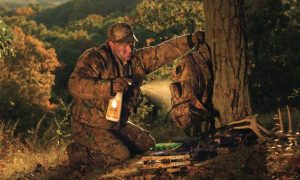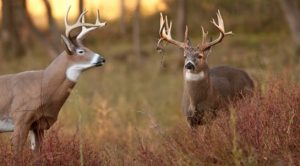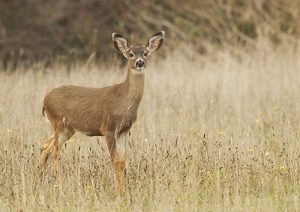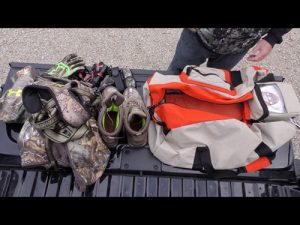Survival Deer Hunting Techniques

The deer hunting season is always so brief yet so intense that it calls for any deer hunter to be thoroughly prepared for it so as to take advantage of each situation that will present itself.
The aim is to become a deer hunter that has all the tricks and skills that are necessary to trick a deer into a range that a nice shot can be taken.
What better way is there to develop skills than to get some deer hunting tips that can be easily understood and implemented by anyone regardless of their hunting expertise.
There are quite some useful tips that have been determined by experienced deer hunters which can land you your priced game come next hunting season.
Additionally the folks over at WildernessToday have an infographic on the best places to shoot a deer.
The notable tips that will nullify the need to ask how fast can a deer run?
including the ones listed below:
Cover Scent

lt is important to fully cover up your scent when you go for deer hunting. This is because deer are capable of detecting human smell for up to a mile away.
Deer can also detect any smell left on the ground and in the air.lt is, therefore, advisable that hunters use scent eliminators to prevent deer from detecting them.
lt can simply be sprayed on the bottom of hunting boots and hunting stands located in the woods.
Hunters can also invest in scent-free soaps before embarking on deer hunting trips. Bathing with scent-free soaps is the only way of ensuring that the hunter’s scent is not left in the air.
Dupe Deer

lt is vital to trick deer using calls or decoys if you desire to be successful in deer hunting. This mainly serves to bring deer into the hunter’s range where a clean shot can be taken.
Modern decoys are just exemplary as they are designed with lifelike features. Attention should be directed to the setup of the decoy as it is the main determinant of success.
Alternatively, deer hunters can use calls. Calls can be produced by bleat cans and grunt tube. Hunters can even attempt rattling antlers as a way of luring deer to take a perfect shot.
Calls can also be made with the mouth after some practice. This is even better as it frees up the hunter’s hands for accurate shooting and safer gun handling.
lt is very important to learn the techniques of using the and when they are appropriate so as to increase your chances of success.
Deer Attractants

This is yet another successful strategy that has repeatedly been used by deer hunting veterans.
There are several types of deer attracts in the market today; they range from deer feeders, deer urine and even deer feed.
These attractants are a good way of attracting deer to your hunting stand from which a close range short that is more relative accurate can be taken from.
Using A Bow
The use of a compound bow in deer hunting has turned out to be a pretty good idea. The bow should fit both your strength and your size to guarantee comfort during use.
Hunting deer using a bow and arrow requires adequate training for one to fully hone the archery skills required.
This can be achieved by practicing shooting at different positions and elevations using locally available targets.
The recommended Arrowhead is razor-sharp broadheads as they are quite efficient about hunting game and also leave behind a good trail of blood.
With such arrowheads, hunters will no longer need to ask how fast a deer can run?
Quiet

Deer have an exemplary sense of hearing. ln fact, deer can detect movements that are up to 0.25 miles away on non-windy days.
Unfortunately, deer can take a period of up to two whole hours to return if they detect suspicious movements. It is, therefore, advisable to set up hunting stands two days in advance to avoid making unnecessary noise through movements.
Hunters can also try walking carefully through the woods so as not to scare off deer.
Hunting stores also have boot covers or hunting boots that are specially designed to be sound eliminating; they can greatly reduce sound produced while walking.
When To Hunt
Deer activity is highest in the early morning and near dusk, these are the best times to hunt.
Stands meant for evening hunts ought to be set up next to deer feeding areas while the morning hunts ought to target their routes to bedding.
Where to hunt
It is vital for hunters to scout for deer hunting grounds before the onset of the hunting season. The ideal hunting location that needs to be discovered is where they mate, drink, defecate and feed.
However, it should be noted that different seasons of the year put deer in different home ranges but which can be easily identified through indicators such as droppings and tracks.
Dressing

Comfort is important for successful deer hunting and that is why is necessary for hunters to always dress warmly while in the woods. Hunters should invest in heated socks, hunting jacket, good quality boots and warm gloves. This is because cold can ruin a good hunting day.
Small Area
Deer hunting should be carried out in a small acreage, preferably a ridge or a trail. Concentrate on heavy used areas or corridors to increase chances of success rather than to roam over a wide country.
Weather
Deer activity is very high before a storm; they will carelessly move to feeding areas at this time even if it is during the day.
The period just right after a storm is also ideal for hunting as they like feeding at this time as well. Deer hunters should be highly vigilant on their feeding areas during such weather, farm fields and oak woodlots are good feeding grounds.
Conclusion
The above insightful information about deer hunting tips outlines the top skills, tricks, and tips that are required to be incorporated into successful deer hunting. They are both easy to understand as well as to implement and are meant to develop both newbie deer hunters as well as experienced ones

